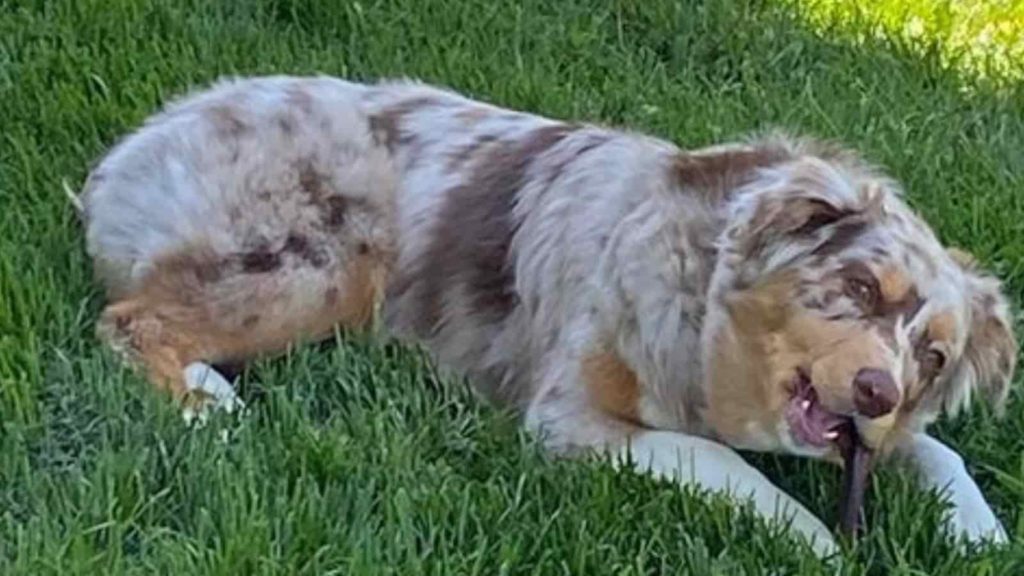Australian Shepherds are intelligent and energetic dogs known for their herding abilities and loyalty. However, like any other breed, they may exhibit unwanted behaviors, such as biting.
Training an Australian Shepherd not to bite is crucial for their safety and the well-being of those around them.
This article provides a comprehensive guide on how to train an Australian Shepherd not to bite, focusing on positive reinforcement techniques and effective strategies for behavior modification.
Disclaimer: This post may contain affiliate links. We only recommend high-quality products that are used and recommended by real owners. If you use these links to buy something we earn a small commission.
Understanding Australian Shepherds and Their Behavior
Before diving into the training process, it is essential to understand the nature of Australian Shepherds and their behavioral tendencies. Australian Shepherds are highly intelligent, active, and sensitive dogs. They are known to have a strong herding instinct, which may manifest as nipping or biting behaviors. Additionally, puppies tend to explore the world using their mouths, which can lead to biting habits if not appropriately addressed.

Reasons Why Australian Shepherds Bite
There are several reasons why Australian Shepherds may resort to biting:
- Teething: Like human infants, Australian Shepherd puppies go through a teething phase. Biting and chewing help alleviate discomfort, but it’s essential to redirect their chewing behavior to appropriate items.
- Lack of socialization: Australian Shepherds require early and ongoing socialization with various people, animals, and environments. Insufficient socialization can lead to fear or anxiety, which may manifest as aggressive behavior.
- Fear or protectiveness: Australian Shepherds are known to be protective of their families. If they perceive a threat or feel fearful, they may resort to biting as a defensive mechanism.
- Lack of exercise and mental stimulation: Australian Shepherds are highly active dogs that require regular exercise and mental stimulation. A lack of physical and mental outlets can lead to frustration and a higher likelihood of biting.
1. Establishing Leadership and Building Trust
To effectively train an Australian Shepherd not to bite, it is crucial to establish yourself as the pack leader and build a foundation of trust. Dogs are pack animals and respond positively to clear leadership. Use positive reinforcement techniques and consistent training to establish trust and respect between you and your Australian Shepherd.
2. Providing Sufficient Exercise and Mental Stimulation
Australian Shepherds have high energy levels and require ample exercise to keep them physically and mentally stimulated. Engage in activities such as daily walks, interactive play sessions, and obedience training to fulfill their exercise and mental stimulation needs. A tired dog is less likely to engage in biting behaviors out of boredom or excess energy.
3. Socializing Your Australian Shepherd
Socialization plays a vital role in training an Australian Shepherd not to bite. Introduce your dog to various people, animals, and environments from an early age. Gradually expose them to new experiences, ensuring positive interactions and rewarding good behavior. This process helps them develop confidence and reduces the likelihood of fear-based aggression.
4. Positive Reinforcement Training Methods
Positive reinforcement is a highly effective training approach for Australian Shepherds. It involves rewarding desired behaviors and ignoring or redirecting unwanted behaviors. When your Australian Shepherd displays appropriate behavior, such as refraining from biting, immediately praise and reward them with treats, verbal praise, or playtime. This positive association encourages them to repeat the desired behavior.
5. Redirecting and Distracting Biting Behavior

When your Australian Shepherd attempts to bite or nip, it’s important to redirect their attention and provide an alternative behavior. Offer them a chew toy or a bone specifically designed for teething puppies. By redirecting their biting behavior onto appropriate items, you teach them what is acceptable to chew on and what is not.
6. Using Toys and Chewables as Alternatives
To prevent biting, provide your Australian Shepherd with a variety of toys and chewables that are safe and suitable for their size and age. Interactive toys, such as puzzle toys or treat-dispensing toys, can keep them mentally stimulated and distracted from biting. Rotate their toys regularly to keep them engaged and prevent boredom.
7. Clicker Training
Utilize clicker training to reinforce desirable behavior and teach bite inhibition. When your dog displays gentle mouthing or stops biting upon command, click the clicker and immediately provide a treat or verbal praise. Over time, they will associate the click with positive reinforcement and learn to inhibit their biting instinct.
7. Managing the Environment to Prevent Biting
Creating a safe and secure environment is essential to prevent biting behavior. Remove any objects or situations that may trigger your Australian Shepherd’s biting tendencies. Keep valuable items out of reach, and ensure your dog has a designated space with their own bed, toys, and water bowl. Properly secure your yard or living space to prevent escape, which may lead to aggressive behaviors.
8. Seeking Professional Help if Necessary
If your Australian Shepherd’s biting behavior persists or escalates despite your best efforts, consider seeking professional help. A certified dog trainer or animal behaviorist can assess the situation, identify any underlying issues, and provide specialized guidance and training techniques tailored to your dog’s specific needs.
9. Consistency and Patience in Training
Training an Australian Shepherd not to bite requires consistency and patience. Be consistent in enforcing rules and boundaries, and ensure that all members of your household are on the same page when it comes to training techniques. Remember that behavior change takes time, so be patient and persistent with your training efforts.

Conclusion
Training an Australian Shepherd not to bite is a crucial aspect of their overall behavior and well-being. By understanding their nature, addressing underlying causes, and employing positive reinforcement techniques, you can successfully modify biting behaviors and foster a strong bond with your Australian Shepherd based on trust and respect.
FAQs
- Q: Why do Australian Shepherds have a tendency to bite?
- A: Australian Shepherds may bite due to reasons such as teething, lack of socialization, fear or protectiveness, and a lack of exercise and mental stimulation.
- A: Australian Shepherds may bite due to reasons such as teething, lack of socialization, fear or protectiveness, and a lack of exercise and mental stimulation.
- Q: Can I train my Australian Shepherd not to bite on my own?
- A: With dedication, patience, and consistent training, you can train your Australian Shepherd not to bite. However, seeking professional help may be beneficial if the biting behavior persists.
- A: With dedication, patience, and consistent training, you can train your Australian Shepherd not to bite. However, seeking professional help may be beneficial if the biting behavior persists.
- Q: How long does it take to train an Australian Shepherd not to bite?
- A: The duration of training varies depending on the individual dog and the consistency of training. It can take several weeks to several months to see significant improvement in biting behavior.
- A: The duration of training varies depending on the individual dog and the consistency of training. It can take several weeks to several months to see significant improvement in biting behavior.
- Q: Are there any specific toys or chewables recommended to prevent biting?
- A: Look for toys and chewables specifically designed for teething puppies or durable toys suitable for Australian Shepherds. Avoid items that may splinter or pose a choking hazard.
- A: Look for toys and chewables specifically designed for teething puppies or durable toys suitable for Australian Shepherds. Avoid items that may splinter or pose a choking hazard.
- Q: What should I do if my Australian Shepherd bites someone?
- A: If your Australian Shepherd bites someone, seek immediate medical attention if necessary. Take steps to prevent future incidents, including identifying triggers, reinforcing training, and consulting a professional dog trainer or behaviorist for guidance on addressing the aggression.
- Q: Can I use punishment to stop my Australian Shepherd from biting?
- A: It is not recommended to use punishment as a training method for biting. Punishment can escalate fear and aggression in dogs. Instead, focus on positive reinforcement techniques and redirecting their behavior onto appropriate alternatives.
- A: It is not recommended to use punishment as a training method for biting. Punishment can escalate fear and aggression in dogs. Instead, focus on positive reinforcement techniques and redirecting their behavior onto appropriate alternatives.
- Q: Is it normal for Australian Shepherd puppies to bite during play?
- A: Yes, it is normal for Australian Shepherd puppies to engage in biting behavior during play. However, it is crucial to teach them bite inhibition by discouraging hard biting and redirecting their attention to toys or appropriate playmates.
- A: Yes, it is normal for Australian Shepherd puppies to engage in biting behavior during play. However, it is crucial to teach them bite inhibition by discouraging hard biting and redirecting their attention to toys or appropriate playmates.
- Q: Can neutering or spaying help reduce biting behavior in Australian Shepherds?
- A: Neutering or spaying can help reduce certain aggressive behaviors, but it is not a guaranteed solution for biting. Training, socialization, and addressing the underlying causes of biting are essential for behavior modification.
- A: Neutering or spaying can help reduce certain aggressive behaviors, but it is not a guaranteed solution for biting. Training, socialization, and addressing the underlying causes of biting are essential for behavior modification.
- Q: Are Australian Shepherds suitable for families with children?
- A: Australian Shepherds can be excellent family dogs, but proper training, supervision, and socialization are crucial, especially when there are young children involved. Teaching children how to interact with dogs respectfully is also important to prevent biting incidents.
- A: Australian Shepherds can be excellent family dogs, but proper training, supervision, and socialization are crucial, especially when there are young children involved. Teaching children how to interact with dogs respectfully is also important to prevent biting incidents.
- Q: Are there any specific signs that indicate an Australian Shepherd is about to bite?
- A: Some common signs that an Australian Shepherd may be about to bite include growling, bared teeth, stiff body posture, raised hackles, and a fixed stare. It is important to recognize these warning signs and take appropriate measures to prevent biting.



